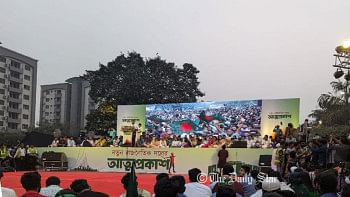Six Points and June 7, 1966
On February 5, 1966, Sheikh Mujibur Rahman, general secretary of the East Pakistan Awami League, revealed in Lahore a broad-ranging formula for regional autonomy. That formula was the Six Point plan, which in time would lead to a wider movement and eventually an armed struggle for East Pakistan's emergence as the independent People's Republic of Bangladesh. The plan put Mujib and a large section of Bengali Awami Leaguers on a collision course with the All-Pakistan Awami League led by Nawabzada Nasrullah Khan. It also aroused the fury of Field Marshal Mohammad Ayub Khan, who openly threatened to use what he called the language of weapons against the proponents of the Six Points. In Ayub's view, the plan would lead to Pakistan's break-up with the secession of its eastern province from the rest of the country. Foreign Minister Z.A. Bhutto challenged Mujib to a public debate on the Six Points at Dhaka's Paltan Maidan. Tajuddin Ahmed accepted the challenge. In the event, Bhutto did not turn up.
The Six Points, which the East Pakistan Awami League formally adopted on 18 March 1966, were the following:
1. Pakistan will be a federation in the true sense on the basis of the Lahore Resolution of March 1940, with the form of government being parliamentary in nature and elected through universal adult franchise;
2. The federal government shall deal with only two subjects, namely, foreign affairs and defence, with all other subjects to be handled by the federating units;
3. Two separate but freely convertible currencies for the two wings of Pakistan may be introduced or a single currency be used, with guarantees that there will be no flight of capital from East to West Pakistan, the guarantees being in the form of a separate reserve bank for East Pakistan;
4. Powers of taxation and revenue collection shall vest in the federating units, with the federal government to be provided with its share of taxes through levies of a certain percentage from all state taxes;
5. There shall be two separate accounts for foreign exchange earnings for the two wings;
6. A separate paramilitary force shall be set up for East Pakistan.
Mizanur Rahman Chowdhury played a highly visible and prominent role as he prepared the demoralized party for the strike. The hartal was observed in totality throughout East Pakistan. Following the hartal, the AL decided, formally on July 23-24, to launch the second phase of the movement in August. Amena Begum, secretary of the women's branch of the Awami League, launched the second phase at a public meeting on August 17, 1966 in Chittagong. In the same month, she and Syed Nazrul Islam embarked on a tour of the province as part of a campaign to popularize the Six Point programme.

 For all latest news, follow The Daily Star's Google News channel.
For all latest news, follow The Daily Star's Google News channel. 



Comments